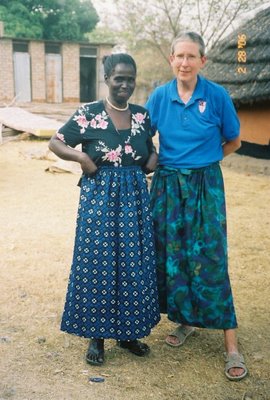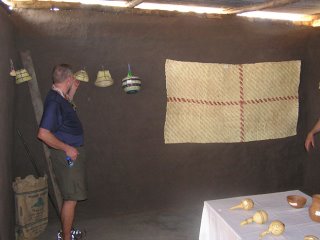All through our week in Lui, Deborah had told us that the Mother’s Union had been working very, very hard to make crafts that we might buy. They had been preparing various crafts – sewing, pottery, and basketry – to sell to us.
Operating on “East Africa Time” as we were, we had remained very relaxed about when we would have that “market opportunity.” That's the reason we took our Lui "walk-about," which I have already described.
As the day wore on, we kept asking when the craft fair would begin, for we were eager to see the crafts the Lui women had prepared. We were eager to see their crafts, mostly because this would be one of our few opportunities to support what is emerging as their “economy.” It was clear to us that the Mother’s Union was looking forward to that opportunity. I never did get complete clarity about where the proceeds of that market would go. I gather it would fund schools (which the Mother’s Union supports) and support of the Cathedral. I’m not sure what else it would support.
We were trying to remain relaxed as we were operating on “East Africa Time” and did not want to rush the Mothers' Union. It was pretty funny. We kept asking, “When??” And again and again we were told, “Soon.”
Finally, though, we were told that they were ready, and the craft market was open.
We did not knock each other down. But we certainly were eager to outrun and outbid and outbuy each other. It was like a competition for who could spend the most money in support of our Lui friends.
It’s not like they had hundreds of items for us. There weren’t hundreds; maybe there were 5 dozen items. But it was clear to me that the items they offered were made with careful craftsmanship.
This photo probably requires some explanation. I’m a fool for pottery, and I love this photo. As soon as I arrived at their craft fair, I was drawn to this lovely bowl.
 I loved it for its own aesthetic qualities, but also asked Varina how the Moru would use this bowl. She explained that you would fill it with food, then drink the juices. We took this photo. She said I should put food in it, and "chow down" -- and to illustrate the point, she rubbed my belly while I demonstrated the "chow-down" purpose of the bowl. At the moment – when the photo was taken – it was just funny.
I loved it for its own aesthetic qualities, but also asked Varina how the Moru would use this bowl. She explained that you would fill it with food, then drink the juices. We took this photo. She said I should put food in it, and "chow down" -- and to illustrate the point, she rubbed my belly while I demonstrated the "chow-down" purpose of the bowl. At the moment – when the photo was taken – it was just funny.Now, I have that bowl sitting in my house. And it always humbles me. Every time I look at it, I am reminded that I have more food than I need, and that this Moru woman -- who took such delight in imagining how I would use it back home -- is still hungry. She may be among the many people in Lui who are starving today. All of a sudden, this memory is not so amusing.
Thanks to the work Deborah has done with the Moru women – and introducing them to the sewing machine – there were also some nice dresses and skirts.
 Sandy was happy to get one of their prize creations. And the Lui women showed her how to tie the headdress.
Sandy was happy to get one of their prize creations. And the Lui women showed her how to tie the headdress.
Varina had made a skirt that caught my eye.

She and I talked, and I wanted to take that skirt home to my priest. Varina was very excited that I had a woman as my priest, and was happy to send that skirt home with me to the U.S.
They had prepared many woven goods – especially baskets. All of us wanted to take a basket home.
Most of the baskets were woven of palm or sorghum grass. The craftsmanship there was impressive. I think all of us came away with at least one basket.
One item that particularly caught our attention was a woven mat, made of the materials and in the pattern that the Moru used at church when they knelt at the Eucharist. Here it is, displayed at Rick's right.

We quickly decided we wanted to buy it for Deborah, who has been living in Lui for several months with a hard-packed dirt floor in her tukal. We loved the idea that Deborah would finally get to have a palm floor for her tukel instead of the dirt floor.
I expect that when someone has lived among the Moru for as long as Deborah did, you probably get used to the fact that there are no "floors" as we think of them. But at that time and in that place, if felt to us like a special gift to give Deborah a "floor" to stand upon.
So we bought it, and had great fun presenting it to Deborah that evening, on our last night in Lui.

And here it is
 in Deborah’s tukal.
in Deborah’s tukal.Not too long after we got home, I saw one of Deborah’s blog entries, which told us what became of that palm mat. A group of women and children had been victimized by tribal warfare, and needed a warm, dry place to rest. Deborah gave them that palm mat to sleep on and give them protection from the hard ground. I cannot express how happy I am to learn of the use Deborah made of that simple mat. I could not have been more happy about the mat’s use!
And it made me realize: When we gave that mat to Deborah, we thought it would be a nice “creature-comfort” for her – to give her some protection against the hard-packed dirt floor. But it turned out that it gave some women and children some comfort against death and violence. I am glad it was useful.
The next day -- after the "craft fair" -- Deborah announced to all the village elders and diocesan leaders how much we had contributed to Lui through that craft fair. If memory serves, we had contributed over 400,000 Ugandan dollars. That’s enough to send more than 50 children to school for a semester!





